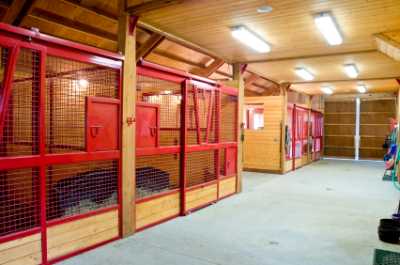|
By Jerry Tardif

|
Many barns waste electricity.
It may sometimes be caused by the fact that our minds are occupied by still another horse-care responsibility.
But it is also because many different people frequent barns (the owner, hired help, boarders, trainers, etc.) and they all have different habits when it comes to responsibility and conservation.
|
|
The lights are on, but nobody's home...
|
|
Here are some suggestions for reducing electricity costs in a barn, some obvious, perhaps others not.
- Turn off all lights when they're not being used.
I know this is obvious, but I'm always surprised at how many people leave lights on for hours when no one is around to use their light.
Stall lights are left on, bathroom lights are left on, etc.;
- Separate light circuits into natural sections.
For example, there's no need for your feed room and wash stall lights to go on together or when stall lights are turned on — they're separate functions.
Feed room lights are only needed when feeding — they should be turned off the rest of the day.
Similarly, you only need the wash stall lights on when washing a horse and you shouldn't have to turn on stall lights to enable the wash stall circuit.
Special Note: Not related to electricity costs, but I strongly recommend using a spray-proof light fixture in the wash stall so that an accidental spray onto the wash stall light doesn't cause thermal shock and broken glass to fall on you and your horse;
- It's worth the cost of an electrician to wire each individual stall light to its own switch.
It's rare for every horse owner to be in the stall with their horse at the same time.
So, why are multiple or all stall lights on just one switch in so many barns?
You should turn on the lights just in the stalls where someone is working (checking a horse, mucking a stall, etc.);
At the very least, reduce the number of stall lights so that, say, only two, three, or four stalls are lit by flipping a switch.
This is cheaper than paying an electrician to install a switch for each individual stall, but will still reduce working in stalls to lighting several rather than all or half the barn.
- Most tack rooms have their own lighting circuit.
But most tack room lights are turned on by borders to prep their horse when riding and left on during the entire period that they're out on their ride.
When borders are done in the tack room, they should turn the lights off as they head out to ride.
They can always turn them on again when they return to clean and store their tack;
- Make sure you don't have water leaking from any faucets in your barn.
Many barns are fed water from a well and the well pump requires electricity.
Besides wasting water, leaks cause the pump to run more often and that pump is wasting electricity when the water it pumps is lost;
- If you have hot water in your barn, make sure any electric hot water heaters are adequately insulated.
Electricity is used to heat the water and wasted heat is wasted electricity; and
- Change all incandescent bulbs to CFLs (Compact Fluorescent Lamps) or LED (Light Emitting Diode) lamps.
They use 25% or less electricity to provide the same amount of light.
Even if you did nothing else, changing to one of these types of bulbs everywhere in the barn would significantly reduce your electricity costs.
- Put outside security lighting on an infrared sensor.
Many barns have lights mounted outdoors to dissuade thieves and vandals.
But leaving outdoor lights on all night wastes lots of electricity, even if they're the more cost-effective lighting forms, such as metal halide or high-pressure sodium fixtures.
Often, it's cheaper to use CFLs (or even incandescent or halogen bulbs) that are switched on using an infrared sensor that senses when a person approaches and turns the light on.
The light can be set to remain on for five or ten minutes and then turn off if no further human activity is sensed.
Most of the foregoing is just common sense.
But I'm astounded at just how often I see lights in barns left on constantly with no one around to use the light.
In fact, I see lights left on in barns from the morning's feedings throughout the day even though the horses are all turned out and everyone is elsewhere at work — it's just a waste of electricity and money!
I'm not sure if any of the foregoing pertains to your barn, but based on my experience, these behaviors are pervasive and affect most barns.
I hope this helps in cutting unnecessary costs.
Besides being an avid trail rider, Jerry Tardif is a technology consultant and a horse and nature photographer in SE Connecticut — see his work at: www.jerrytardif.com.
He is also co-founder and President of QueryHorse.
Back to Article Index
|